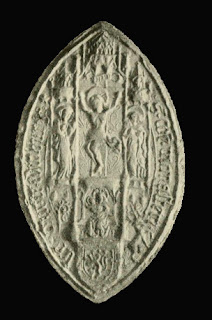Yes, you're right - these aren't Augustinian seals, so this is a tangent.
The Merton seal (from their archives) is from the 14th century. It is the BVM and Babe, she with orb, and with the half-figure of Walter de Merton praying under an arch below. I'd like to draw your attention to the seals of Oseney Abbey and Merton Priory - Walter had associations with both (especially with Merton, whom he named himself after). Both monasteries were, like so many Austin houses, dedicated to the BVM. Merton's chapel is dedicated jointly to the BVM and St John the Baptist. Walter's own seal has similarities to Merton's, too.
A quick look on the internet has failed to provide Univ's seal, but here's Balliol's, from 1282. Although John de Balliol is credited with founding the college, it was actually his wife Dervorguilla of Galloway.
This seal has again the BVM and Babe and is very like Oseney's or, with its canopy, Merton Priory's. But in addition, they BVM and Babe are sitting atop a building (the scholars' hall?), with John and Dervorguilla praying underneath. Unlike Merton College's seal, this one is very heraldic, showing the secular, noble origin of the founders. John holds his shield (Gules, an orle Argent. By the BVM and Babe are, sinister, the arms of her mother Margaret of Huntingdon (Or, three piles Gules. Margaret was great-granddaughter of David I, brother of Edith-Matilda - both of whom were responsible for several early Augustinian foundations. The other arms (per pale Gules and Azure, three garbs Or) are the de Lacy arms. Alan of Galloway married first and thirdly de Lacy women. (It's interesting she displays de Lacy rather than Galloway/ Scotland.) Dervorguilla's own seal is here, for comparison.





